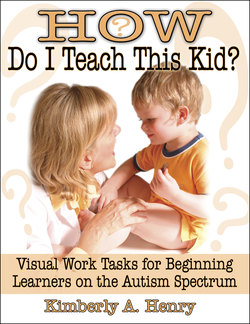Читать книгу How Do I Teach This Kid? - Kimberly A. Henry - Страница 7
На сайте Литреса книга снята с продажи.
ОглавлениеWhat Are Task Boxes?
Task boxes are single, organized activities with a clear beginning and end. All task materials are contained within clearly defined boundaries—trays, boxes, baskets, tubs, folders, binders. Each task is presented with visual organization and clarity. The materials clearly define the activity for the student and tell him how to complete the task. For example, one task may have four cups —one red, one green, one blue, and one yellow—pushed through holes cut in the top of a shoebox, and a container of red, green, blue, and yellow blocks attached to the side of the box. The organization of the task shows the child that he is to sort the blocks by color and place them in the corresponding cups. Additionally, the organization of the task itself teaches the concept of “finished” since the student knows that the task is completed when all of the materials have been used.
Task boxes emphasize students’ visual learning styles, avoiding the need for auditory processing of verbal directions, an area of deficit for many students with autism. The manipulative nature of task boxes provides students with tactile and kinesthetic activities; however, the visual structure and organization of the manipulatives prevents stereotypical spinning, tossing, or stimming with the materials since students can “see” the task to be completed.
The task boxes presented in this resource address six different skill areas: motor tasks, matching, sorting, reading, writing, and math. Motor task boxes are the first step for many children who are just learning to work independently. Skills such as “pulling off” and “putting in” are presented in a visual format to make the task expectation clear to the child. The concept of “finished” is taught by showing the child that the task is finished when all of the materials are gone.
Matching and sorting task boxes are useful for students who have visual discrimination skills and are able to recognize items as being the same or different. Various materials can be used to teach students to match and sort colors, pictures, shapes, and objects. Higher level skills such as sorting by category and filing can also be presented in task box format.
Beginning academic skills in reading, writing, and math can be taught through the use of task boxes. Students can follow a visual structure to sequence letters and numbers, place words in alphabetical order, construct a simple sentence, spell words, demonstrate one-to-one correspondence, extend a pattern—the possibilities are endless! All you need is a little creativity, some organizational containers, and a few manipulatives that you either find or create. You can tailor task boxes to the individual needs of one student or create them to be used by multiple students at different levels.
Initially, the tasks are usually taught within structured teaching sessions and then incorporated into an independent work system as students develop proficiency. Once students have mastered the tasks of three or four boxes, begin to transfer them to an independent work system.
